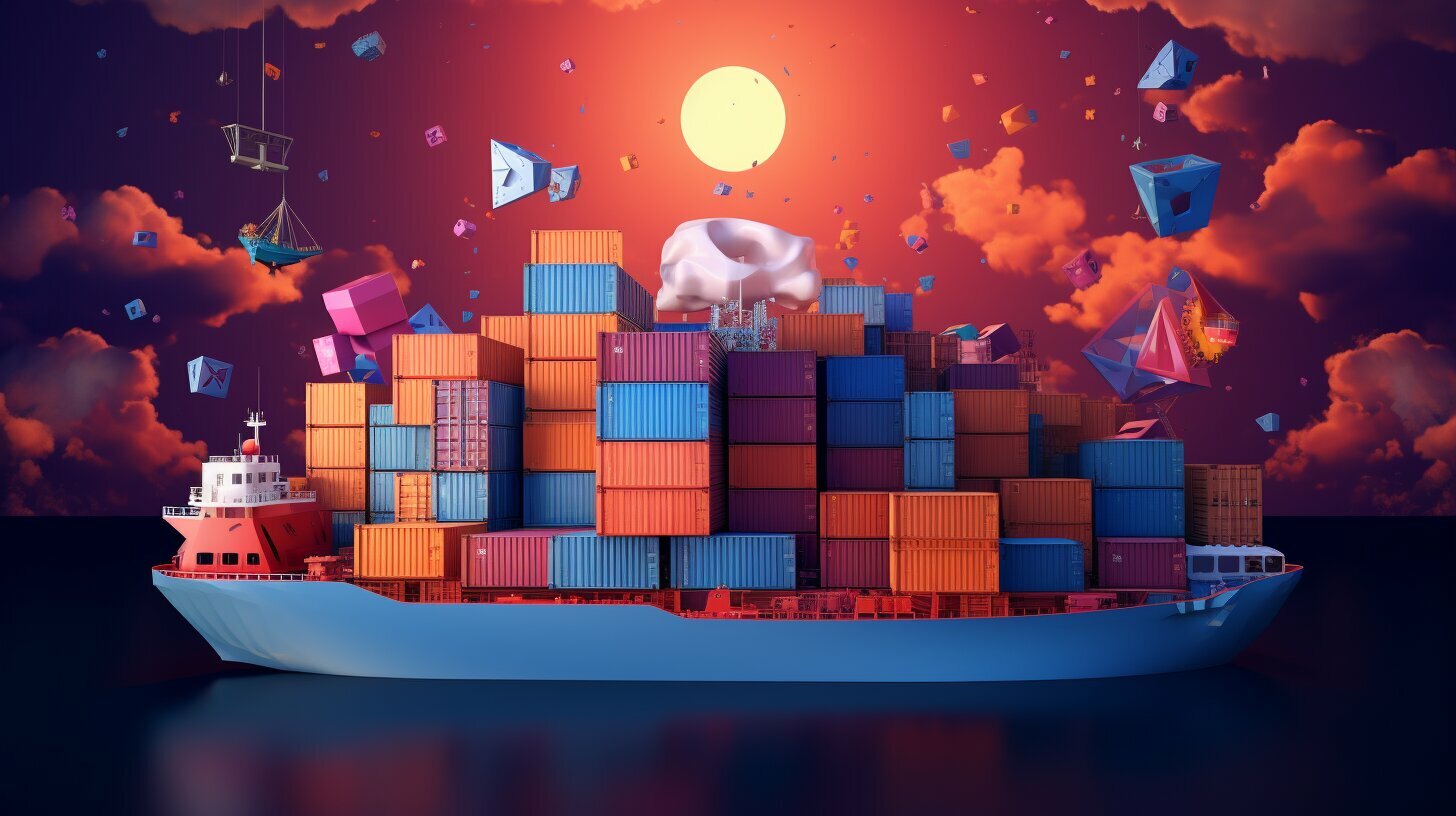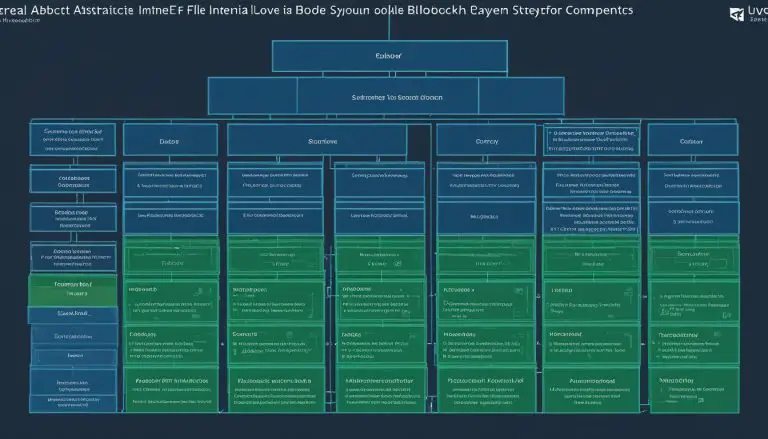Unveiling the Mystery: What is Kubernetes vs Docker Explained
Kubernetes and Docker are two popular technologies in the world of containerization, but what exactly are they and how do they differ? In this article, I will provide a clear explanation of Kubernetes and Docker, addressing the confusion around their roles and differences.
Key Takeaways:
- Kubernetes and Docker are complementary technologies in the containerization space.
- Docker is a suite of software development tools for creating, sharing, and running individual containers.
- Kubernetes is a system for operating containerized applications at scale.
- Docker Swarm is Docker’s own container orchestration system.
- Docker is used for creating and running containers anywhere, while Kubernetes is used for operating containers in production and auto-scaling applications.
Understanding Kubernetes and Docker
Before we can explore the differences between Kubernetes and Docker, it’s important to understand what each of them is and what they offer. Docker is a suite of software development tools that allows developers to create, share, and run individual containers. These containers are lightweight, stand-alone packages that contain everything needed to run an application, including the code, runtime, libraries, and system tools. Docker provides tools for building container images, sharing images through Docker Hub, and running containers with Docker Engine.
Kubernetes, on the other hand, is an open-source container orchestration platform. It automates the deployment and management of containerized applications, allowing developers to focus on writing code rather than managing infrastructure. Kubernetes uses a cluster of nodes to run containerized applications, providing features such as scalability, high availability, portability, security, ease of use, cost reduction, agility, and innovation. It ensures that containers are always running, schedules containers across multiple nodes, and automatically scales applications based on workload demand.
Both Docker and Kubernetes are complementary technologies, but they have different focuses. Docker is primarily used for creating and running containers anywhere, while Kubernetes is used for operating containers at scale. However, they are often used together to deploy and manage containerized applications. For example, developers can use Docker to build and package their applications into containers, and then use Kubernetes to orchestrate and manage those containers in production. This combination provides scalability, agility, and resiliency to containerized applications.
Key Features of Docker and Kubernetes:
| Docker | Kubernetes |
|---|---|
| Creates and runs containers anywhere | Operates containers at scale |
| Offers container orchestration with Docker Swarm | Provides built-in container orchestration |
| Enables easy image sharing through Docker Hub | Automates deployment and management of containerized applications |
| Provides flexibility and portability | Ensures high availability and scalability |
In conclusion, Docker and Kubernetes are powerful tools for containerization and container orchestration, respectively. While Docker focuses on creating and running containers, Kubernetes focuses on operating containers at scale. Together, they offer a comprehensive solution for deploying and managing containerized applications. By understanding their individual strengths and integrating them effectively, developers can harness the full potential of container technology and drive innovation in their applications.
Docker: Creating and Running Containers Anywhere
Docker is a suite of software development tools that revolutionized containerization, allowing developers to create and run containers anywhere with ease. With Docker, applications are packaged into containers, which contain everything needed to run the application, including libraries, dependencies, and configuration files. This eliminates the hassle of dealing with compatibility issues and enables seamless deployment across different environments.
One of the key benefits of using Docker is its flexibility and portability. Docker containers can be run on any operating system that supports Docker, making it an ideal choice for developers working in diverse environments. The ability to create and run containers anywhere greatly simplifies the development process, as it eliminates the need for complex setup and configuration.
In addition, Docker offers a vast library of pre-built container images, known as Docker Hub, that developers can leverage to speed up their development process. These images cover a wide range of applications and services, allowing developers to quickly spin up containers with minimal effort. Docker also provides powerful tools, like Docker Engine, that enable efficient management and orchestration of containers, ensuring smooth operation and scalability.
Docker’s Benefits over Kubernetes
While Docker and Kubernetes are complementary technologies, there are some distinct benefits to using Docker. Docker’s simplicity and ease of use make it an excellent choice for individual developers or small development teams. It offers a streamlined workflow for building, sharing, and running containers, allowing developers to focus on writing code rather than dealing with complex infrastructure.
Furthermore, Docker’s extensive library of pre-built container images and its intuitive command-line interface make it easy to get started and experiment with containers. This flexibility and user-friendliness make Docker a preferred choice for many developers, especially those who are new to containerization or have limited resources.
In conclusion, Docker is a powerful software development tool that enables the creation and running of containers anywhere. Its flexibility, portability, and ease of use make it a go-to choice for developers looking to streamline their development process. While Kubernetes offers advanced container orchestration capabilities, Docker’s simplicity and extensive toolset make it an attractive option for individual developers and small teams.
| Docker | Kubernetes |
|---|---|
| Creates and runs containers anywhere | Operates containers at scale |
| Highly flexible and portable | Provides advanced orchestration and management |
| Ideal for individual developers and small teams | Suitable for large-scale and critical applications |
Kubernetes: Operating Containers at Scale
While Docker is responsible for creating and running containers, Kubernetes takes containerization to the next level with its ability to operate and manage containers at scale. As an open-source container orchestration platform, Kubernetes automates the deployment, scaling, and management of containerized applications.
Kubernetes utilizes a cluster of nodes to run containerized applications, providing features that ensure scalability, high availability, portability, security, ease of use, cost reduction, agility, and innovation. With its auto-scaling capabilities, Kubernetes can automatically adjust the number of containers based on demand, ensuring optimal resource utilization.
In addition to scalability, Kubernetes offers features like self-healing, which ensures that applications are always running by automatically restarting or replacing failed containers. It also provides rolling updates, allowing for seamless application updates without any downtime.
Furthermore, Kubernetes boasts a robust infrastructure for managing configuration, secrets, and storage. It enables the efficient distribution of workloads across multiple nodes, improving load balancing and maximizing performance. Kubernetes also supports advanced scheduling techniques, ensuring that containers are placed on suitable nodes based on resource requirements and constraints.
By combining the container creation and deployment capabilities of Docker with the powerful orchestration features of Kubernetes, organizations can achieve optimal results in managing containerized applications. The integration of Docker and Kubernetes allows for efficient resource usage, automated operations, storage orchestration, system-independent container deployment, and seamless scaling. It provides the scalability, agility, and resiliency required for large-scale containerized applications in production environments.
To summarize, while Docker enables the creation and running of containers, Kubernetes takes containerization to the next level by offering a comprehensive platform for operating and managing containers at scale. Together, Docker and Kubernetes form a powerful duo that addresses the challenges of container orchestration and provides organizations with the tools they need to deploy and manage containerized applications efficiently.
| Benefits of Kubernetes | Benefits of Docker |
|---|---|
| • Scalability | • Portability |
| • High availability | • Flexibility |
| • Resource optimization | • Development and deployment speed |
| • Self-healing | • Ease of use |
| • Configuration management | • Docker Hub for image sharing |
Docker Swarm: Docker’s Container Orchestration System
In addition to Docker and Kubernetes, Docker also offers its own container orchestration system called Docker Swarm. While Kubernetes is a powerful and widely adopted container orchestration platform, Docker Swarm provides an alternative solution for managing containerized applications. With Docker Swarm, you can efficiently deploy and manage containers across a cluster of nodes.
- Docker Swarm simplifies the process of container orchestration by offering a user-friendly interface and straightforward setup. It allows developers to define services and tasks, which are then automatically distributed across the nodes in the swarm.
- One of the key features of Docker Swarm is its built-in load balancing, which ensures that containers are evenly distributed across the cluster. This enables optimal resource utilization and enhances the performance of containerized applications.
- Docker Swarm also provides high availability and fault tolerance. It automatically detects and replaces failed containers, ensuring that your applications remain operational even in the event of node failures.
While Kubernetes offers a more robust and feature-rich container orchestration platform, Docker Swarm is a viable option for smaller-scale deployments or situations where simplicity is preferred. It may be particularly suitable for teams already familiar with Docker, as it leverages Docker’s existing ecosystem and tooling.
Docker Swarm vs. Kubernetes
| Feature | Docker Swarm | Kubernetes |
|---|---|---|
| Cluster Management | Relatively straightforward setup and management | More complex installation and configuration |
| Scalability | Good scalability for small to medium-sized deployments | Excellent scalability for large-scale production environments |
| Load Balancing | Built-in load balancing for distributing containers | Advanced load balancing features and customization options |
| Features | Basic feature set suitable for simpler deployments | Rich set of features for complex, enterprise-grade environments |
Ultimately, the choice between Docker Swarm and Kubernetes depends on the specific requirements of your project. While Kubernetes offers a more extensive feature set and is well-suited for large-scale deployments, Docker Swarm provides a simpler and more lightweight option for smaller-scale environments.
Use Cases of Docker and Kubernetes
Docker and Kubernetes are versatile technologies that find applications in a wide range of use cases, offering unique advantages based on specific requirements. Let’s explore some of the common use cases where each technology excels:
1. Microservices Applications
Docker provides an ideal environment for building and deploying microservices applications. With Docker, each microservice can be encapsulated within a container, allowing for easy scalability, independent updates, and seamless integration. Kubernetes complements Docker by providing powerful orchestration capabilities, enabling efficient management and scaling of microservices across multiple containers.
2. Dynamic Scaling
Both Docker and Kubernetes excel in dynamic scaling scenarios. Docker’s lightweight containers can be quickly spun up or down, allowing applications to scale based on demand. Kubernetes takes scaling to the next level by automating the process, monitoring resource usage, and dynamically adjusting the number of containers based on predefined conditions. This ensures optimal performance and cost efficiency.
3. Continuous Integration and Delivery
Containerization with Docker and orchestration with Kubernetes are fundamental to achieving seamless continuous integration and delivery (CI/CD) workflows. Docker’s containerization streamlines the packaging and deployment of applications, while Kubernetes provides a robust platform for automating the testing, deployment, and monitoring of these containerized applications. This enables faster release cycles, improved collaboration, and more reliable software delivery.
4. Cloud-Native Applications
Docker and Kubernetes are at the forefront of cloud-native application development. Docker’s portability and consistency empower developers to build applications that can run seamlessly across different cloud environments. Kubernetes, with its advanced features like scaling, load balancing, and self-healing, provides the necessary infrastructure for managing and scaling cloud-native applications with ease.
| Use Case | Advantages of Docker | Advantages of Kubernetes |
|---|---|---|
| Microservices | Isolation, portability, flexibility | Orchestration, scalability |
| Dynamic Scaling | Rapid scaling, resource efficiency | Automatic scaling, load balancing |
| CI/CD | Consistent environments, easy deployment | Automated testing, monitoring |
| Cloud-Native | Portability, cross-cloud compatibility | Infrastructure management, resilience |
Whether it’s deploying microservices applications, enabling dynamic scaling, facilitating continuous integration and delivery, or building cloud-native applications, Docker and Kubernetes offer a powerful combination that can meet the demands of modern software development. By leveraging the strengths of each technology, organizations can embrace containerization and orchestration with confidence, unlocking new levels of agility and efficiency.
Challenges in Container Orchestration
While Docker and Kubernetes simplify containerization, there are still challenges to overcome when it comes to orchestrating containers effectively. The process of managing, deploying, and scaling containers at scale requires careful planning and implementation. Here are some of the key challenges that organizations face:
- Container Deployment: Orchestrating the deployment of containers across multiple hosts or nodes can be complex. Ensuring that containers are deployed in a consistent and reliable manner is crucial for maintaining the stability of containerized applications.
- Scaling: As containerized applications grow, scaling becomes necessary to handle increased demand. Container orchestration platforms like Kubernetes allow for automatic scaling by dynamically adjusting the number of container instances based on workload. However, effectively managing this scaling process while maintaining optimal performance can be a challenge.
- Lifecycle Management: The lifecycle of containers involves various stages, including creation, deployment, updating, and termination. Orchestrating these stages and managing container versions, updates, and dependencies can be a complex task.
To address these challenges, Docker and Kubernetes provide solutions that simplify container orchestration. Docker Swarm, for example, is Docker’s own container orchestration system that offers a simplified alternative to Kubernetes. However, Kubernetes remains the preferred choice for large-scale and critical applications due to its advanced features and robustness.
It’s worth noting that while Docker and Kubernetes can be used individually, their integration offers a comprehensive solution for containerized application deployment and management. By leveraging the strengths of both technologies, organizations can achieve greater scalability, agility, and resiliency in their containerized environments. This integration enables optimal resource usage, automated operations, storage orchestration, and system-independent container deployment.
Summary:
While Docker and Kubernetes simplify containerization, challenges with container orchestration remain. Deploying containers consistently, scaling efficiently, and managing container lifecycles are key challenges organizations face. Docker Swarm provides an alternative to Kubernetes but lacks advanced features. The integration of Docker and Kubernetes offers a comprehensive solution, providing scalability, agility, and resiliency to containerized applications.
| Challenges in Container Orchestration |
|---|
| Container Deployment |
| Scaling |
| Lifecycle Management |
Docker vs Kubernetes Security and Resilience
Containerized applications must be secure and resilient, and both Docker and Kubernetes have implemented features to address these crucial requirements. Docker provides built-in security features such as isolation through containers, where each container runs independently and does not have access to the host system. Docker also offers the ability to encrypt container data and control user access through user namespaces. Additionally, Docker provides security scanning tools that can identify vulnerabilities in container images before they are deployed.
Kubernetes, on the other hand, focuses on securing the entire containerized application stack. It uses role-based access control (RBAC) to define and manage user permissions, ensuring that only authorized individuals have access to sensitive resources. Kubernetes also offers network policies to control and secure communication between containers and services. Moreover, Kubernetes enables secure storage and secrets management, allowing sensitive information to be encrypted and securely accessed by authorized containers.
In terms of resilience, Docker Swarm and Kubernetes both provide mechanisms to ensure high availability and fault tolerance. Docker Swarm uses a leader-follower architecture, where a leader node manages the overall cluster state, and follower nodes can seamlessly take over in case of failure. Kubernetes, on the other hand, has a master-worker architecture with multiple master nodes for redundancy. It also supports automatic scaling and load balancing to distribute traffic effectively and maintain application availability.
To summarize, both Docker and Kubernetes offer robust security and resilience features for containerized applications. Docker focuses on container-level security, providing isolation, encryption, and vulnerability scanning. Kubernetes, on the other hand, emphasizes securing the entire containerized application stack, providing RBAC, network policies, and secure storage. Both Docker Swarm and Kubernetes ensure high availability and fault tolerance through their respective architecture and scaling mechanisms.
Table: Docker vs Kubernetes Security and Resilience Features
| Features | Docker | Kubernetes |
|---|---|---|
| Container Isolation | Yes | Yes |
| Encryption of Container Data | Yes | Yes |
| Control User Access | Yes | Yes |
| Vulnerability Scanning | Yes | No |
| Role-Based Access Control (RBAC) | No | Yes |
| Network Policies | No | Yes |
| Secure Storage | No | Yes |
| High Availability | Yes | Yes |
| Automatic Scaling | No | Yes |
Docker and Kubernetes Integration
While Docker and Kubernetes are powerful technologies on their own, their integration can bring even greater benefits in terms of scalability, agility, and operational efficiency. By combining the container creation and sharing capabilities of Docker with the container orchestration and management features of Kubernetes, organizations can streamline their containerized application deployment and management processes.
One of the key advantages of using Kubernetes alongside Docker is the ability to scale applications automatically. Kubernetes provides built-in auto-scaling capabilities that allow applications to adapt to changing demand. This means that as the workload increases, Kubernetes can automatically deploy additional instances of containers to meet the increased demand, ensuring optimal performance and resource utilization.
In addition to scalability, the integration of Docker and Kubernetes also enables greater agility in application deployment and management. Docker’s portability allows containers to run anywhere, making it easier to develop and test applications across different environments. When combined with Kubernetes, organizations can benefit from the platform’s easy deployment and management of containerized applications, ensuring seamless integration and consistent performance in production environments.
| Benefits of Docker and Kubernetes Integration |
|---|
| Scalability |
| Agility |
| Operational efficiency |
In terms of operational efficiency, the integration of Docker and Kubernetes offers features such as automated operations, storage orchestration, and system-independent container deployment. Kubernetes provides advanced capabilities for managing containerized applications, including built-in load balancing, service discovery, and health monitoring. These features ensure that applications are running smoothly and efficiently, minimizing downtime and improving overall operational efficiency.
In conclusion, the integration of Docker and Kubernetes brings numerous benefits to containerized application deployment and management. It enables organizations to achieve scalability, agility, and operational efficiency by leveraging Docker’s container creation and sharing capabilities alongside Kubernetes’ container orchestration and management features. Whether it is auto-scaling applications, deploying containers across different environments, or improving operational efficiency, the integration of Docker and Kubernetes provides a comprehensive solution for organizations seeking to optimize their containerized application workflows.
Real-World Applications of Docker and Kubernetes
To truly understand the value of Docker and Kubernetes, let’s explore some real-world applications where these technologies have made a significant impact.
1. Deploying Microservices Applications:
In today’s digital landscape, businesses are increasingly adopting microservices architecture to build scalable and modular applications. Docker and Kubernetes play a crucial role in deploying and managing these applications. Docker enables developers to package each microservice into a lightweight and portable container, ensuring consistency across different environments. Kubernetes, on the other hand, provides orchestration capabilities, allowing for seamless scaling, load balancing, and service discovery of microservices. This combination of Docker and Kubernetes empowers organizations to deploy complex microservices applications with ease and efficiency.
2. Dynamic Scaling and High Availability:
One of the key benefits of containerization and orchestration is the ability to scale applications dynamically based on demand. Docker and Kubernetes excel in this aspect, enabling organizations to automatically scale their applications up or down to meet fluctuating user traffic. By leveraging Kubernetes’ auto-scaling capabilities, businesses can achieve high availability and ensure uninterrupted service delivery even during peak periods. This dynamic scaling is particularly beneficial for e-commerce platforms, content delivery networks, and other web-based applications that experience varying levels of demand throughout the day.
3. Continuous Integration and Delivery (CI/CD):
The adoption of DevOps practices has transformed software development, with CI/CD pipelines becoming the standard for efficient and rapid application deployment. Docker and Kubernetes are integral components of these pipelines. Docker’s ability to create reproducible and isolated environments aids in testing and deployment, while Kubernetes’ automated deployment and rolling updates enable seamless integration and delivery of new features. Together, Docker and Kubernetes facilitate the rapid release of software updates, minimizing downtime and accelerating time-to-market for businesses across various industries.
| Use Cases | Benefits |
|---|---|
| Deploying Microservices Applications | Consistency, scalability, and modularity |
| Dynamic Scaling and High Availability | Efficient resource utilization and uninterrupted service delivery |
| Continuous Integration and Delivery (CI/CD) | Rapid deployment, minimized downtime, and faster time-to-market |
Conclusion
Docker and Kubernetes have revolutionized the way applications are developed, deployed, and managed. Their real-world applications span various industries and use cases, from microservices deployment to dynamic scaling and continuous integration. By leveraging Docker and Kubernetes, organizations can achieve consistency, scalability, high availability, and accelerated time-to-market. The integration of these technologies offers a comprehensive solution for containerized application deployment and management, enabling businesses to thrive in the era of digital transformation.
The Future of Docker and Kubernetes
As technology continues to evolve, Docker and Kubernetes are at the forefront of containerization innovation, shaping the future of application deployment and management. These two technologies have revolutionized the way software is developed, deployed, and scaled, offering increased efficiency, flexibility, and scalability to businesses across industries. With their extensive capabilities and ongoing advancements, Docker and Kubernetes are set to play a vital role in the ever-changing landscape of containerization.
One of the key areas where Docker and Kubernetes are driving innovation is the deployment of cloud-native applications. As organizations increasingly adopt cloud-native architectures, these technologies provide the necessary tools and frameworks to seamlessly build, deploy, and manage applications in a cloud environment. By harnessing the power of containers and orchestration, Docker and Kubernetes enable organizations to achieve higher levels of scalability, fault tolerance, and resilience in their cloud-native applications.
Furthermore, the integration of Docker and Kubernetes also paves the way for advancements in edge computing. As the demand for applications running on edge devices continues to rise, Docker and Kubernetes offer a solution for deploying and managing containerized applications at the edge. This enables faster processing, reduced latency, and improved performance for edge applications, opening up new possibilities in areas such as Internet of Things (IoT), industrial automation, and smart cities.
Table: Use Cases of Docker and Kubernetes
| Use Case | Docker | Kubernetes |
|---|---|---|
| Microservices applications | ✓ | ✓ |
| Dynamic scaling | ✓ | ✓ |
| Edge computing | ✓ | ✓ |
| Continuous integration and delivery | ✓ | ✓ |
| Cloud-native applications | ✓ | ✓ |
In conclusion, Docker and Kubernetes are poised to have a significant impact on the future of containerization. As technology continues to advance, these technologies will continue to evolve and enhance their functionalities, further empowering organizations to embrace the benefits of containerization. Together, Docker and Kubernetes provide a comprehensive solution for deploying, scaling, and managing containerized applications, enabling businesses to achieve higher levels of efficiency, scalability, and innovation in their software development processes.
Conclusion
In conclusion, Docker and Kubernetes are powerful technologies that play distinct roles in containerization, and their coexistence provides an optimal solution for successfully running and managing containerized applications.
Docker is a suite of software development tools used to create, share, and run individual containers. It allows containers to be created and run anywhere, providing flexibility and portability. Docker also offers its own container orchestration system called Docker Swarm, which provides features for managing containerized applications.
Kubernetes, on the other hand, is an open-source container orchestration platform that automates the deployment and management of containerized applications. It excels at operating containers at scale, offering features such as auto-scaling, high availability, and security. Kubernetes is often used in large-scale and critical applications due to its resilience and advanced container management capabilities.
When used together, Docker and Kubernetes provide a comprehensive solution for containerized application deployment and management. Their integration allows for optimal resource usage, automated operations, and flexible deployment. Docker can be used to create and run containers, while Kubernetes takes care of orchestrating and managing them in production environments.
Overall, Docker and Kubernetes are not mutually exclusive, but rather complementary technologies that enable organizations to harness the benefits of containerization. By leveraging the unique strengths of each platform, businesses can achieve scalability, agility, and resilience in their containerized applications.
FAQ
What is Docker?
Docker is a suite of software development tools for creating, sharing, and running individual containers.
What is Kubernetes?
Kubernetes is a system for operating containerized applications at scale.
How are Docker and Kubernetes different?
Docker is used to create containers that can run anywhere, while Kubernetes is used to operate containers in production and can auto-scale applications.
Does Docker have its own container orchestration system?
Yes, Docker offers its own container orchestration system called Docker Swarm.
What are some use cases of Docker and Kubernetes?
Docker and Kubernetes are used for deploying microservices applications, dynamic scaling, running containerized applications on edge devices, continuous integration and delivery, and cloud-native applications.
What are some challenges in container orchestration?
Container orchestration challenges include container deployment, scaling, and managing the lifecycle of containers.
Which is more suitable for large-scale and critical applications: Docker Swarm or Kubernetes?
Kubernetes is more suitable for large-scale and critical applications due to its security features and resilience.
Can Docker and Kubernetes be used together?
Yes, Docker and Kubernetes can be used together to provide scalability, agility, and resiliency to containerized applications.
What are some benefits of integrating Docker and Kubernetes?
The integration of Docker and Kubernetes allows for optimal resource usage, software health monitoring, automated operations, storage orchestration, and system-independent container deployment.
- About the Author
- Latest Posts
Mark is a senior content editor at Text-Center.com and has more than 20 years of experience with linux and windows operating systems. He also writes for Biteno.com






